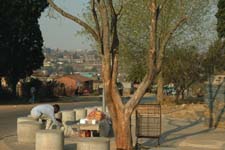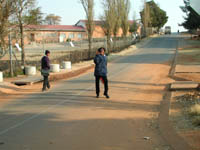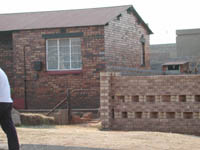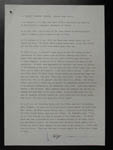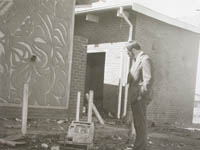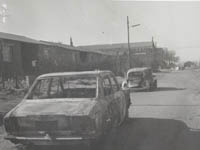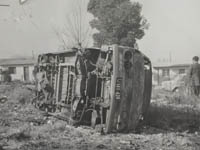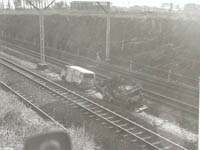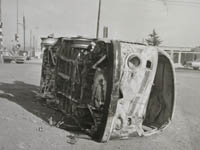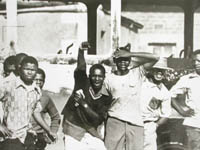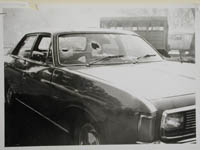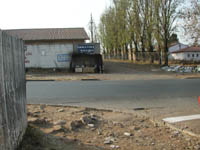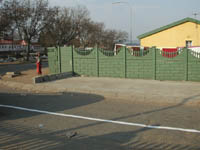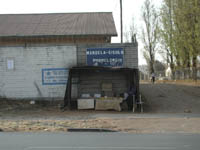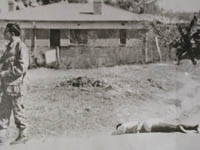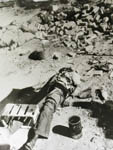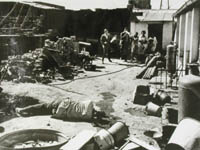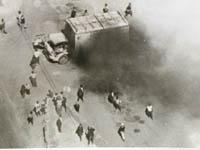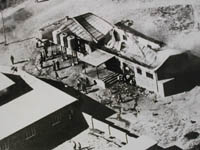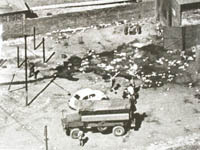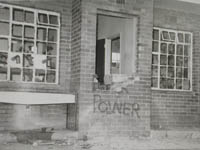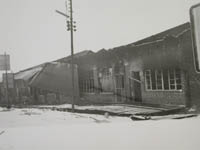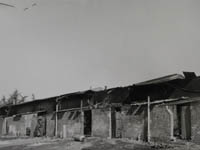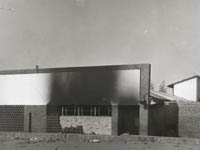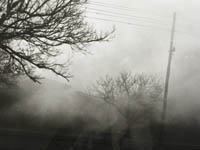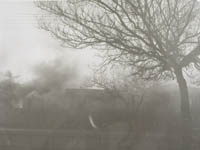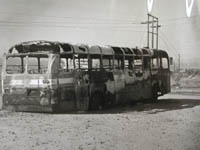Table of Contents
Acknowledgments Readers' Guide
Introduction The Narrative Official Stories The Participants Afrikaans Memory and Violence Final Thoughts Archive
Abbreviations Glossary
Gutenberg-e.org Columbia University Press
Chapter 2
"I Heard There Was a Riot in Soweto…:" A Narrative of June 16, 1976
The Shooting
50
Until then, no one had been hurt. But after about five minutes the children once again surged forward, throwing more stones.
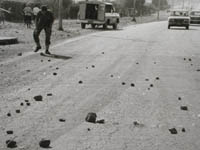
Ek het gesien dat 'n Bantoe sersant teen die kop getref word en geweldig bloei aan die regterkant van sy kop. 'n Klip het my getref teen die regterknie. My been het onder my ingevou en teen die pad neergeval. Ek kon nie op my been staan nie. Met die het ek 'n bevel gehoor "TREK VUURWAPENS EN VUUR!" Ek het gesien luit.-kol. Kleingeld vuur 'n sarsie na die regterkant van die skare en ander lede het ook gevuur. Ek self het opgestaan, my vuurwapen getrek.I saw that a Bantu sergeant was hit against the head and that he bled heavily on the right side of his head. A stone hit me against my right knee. My leg buckled under me and fell down on the road. I could not stand on my leg. With that I heard a command: "DRAW WEAPONS AND SHOOT." I saw Colonel Kleingeld fire a round at the right-hand side of the crowd and other members [of the police] also fired. I stood up myself, drew my weapon.43What's this?(See Hattingh statement)
Something was about to transform what had been an impassioned and raucous student march into a catastrophe of outrage, panic, and deadly assault.
| Layered Narratives: | Police | Press | Cillié Commission |
Shooting
"At that point … the stone throwing began at the police, and live ammunition was actually used," according to Morobe. Tema stated, "Then I saw two or three in the front row who had stones and they hurled them at the police":
Then one of the police who was on the extreme right, he was in uniform and it was a White policeman, pulled out a revolver and he pointed it to the students who were more towards the right…55
He aimed at the students. At that time Stanley, our driver, screamed and said: Look at him, he is shooting at the kids!44
In February 1977, 21-year-old Murphy Morobe testified before the Cillié Commission and told his story of what had happened:
On the 16th June, 1976, I left my home for school at 7 a.m. and got to school at about 8:15 a.m. I was delayed by transport and had my placard with me, with words "Away with Afrikaans". I had made it on my own. On arrival I found that the students had already left the school premises and I managed to trace them in the direction of Tifile Secondary School. I joined the procession and moved on towards White City and met pupils from neighbouring schools and moved on towards Mavulo, that is on the road to Dube.
We moved past Dube towards Orlando West and there were no incidents nor police interference till we came to Orlando West. Before we reached Orlando West High School we were stopped by Mashinini who informed us that he has got the word that police are in the vicinity and said that there is no turning back, we have just got to go on and there was a roar of approval. The students were singing all along route Nkosi Sikalele Afrika.
The demonstration moved towards Orlando West High School and here there were also other students waiting for our arrival. On joining them I went into Orlando West High School premises to inform the students here that the others were waiting for them. I told the students who were outside the classes to come and join and they did join others. Outside the school premises I was unable to leave through the gate as the teargas had been fired by police before I could get out. The alternative route I could get was to scale the school fence and then join the other students, which I did.
By the time I joined the students, I found them throwing stones at the police outside Orlando West High School and I also joined the students in throwing stones at the police. The police were moving down into the mob and the students then scattered.45 Murphy "Mafison" Morobe60
Cillié Testimony, 9 February 1977
Police Statement, January 1977
TRC testimony, July 1996.
Sixteen years later, Morobe, remembered "as the police were moving out of the area, that's when some of them started shooting directly into the crowd at quite close range, and it's at that point that Hector Pieterson was shot and killed."46 Victor Dladla lived behind the school where the shooting took place. He saw the police twice try to stop the procession but then one policeman "took out his gun and shot a boy who fell." Dladla remembered he thought immediately that the boy was dead and that it was "at that moment" when "the children spread and picked up stones. They started throwing stones at the police."47
Antoinette Musi had seen the police convoy and hidden in one of the houses nearby. She saw her brother, a thirteen-year-old student at the Ishetsepeng Higher Primary School, emerging from around a corner and called to him. "I then asked him not to go away but stand in front of me," where she could keep an eye on him. He was there for a short while but then she could not see him anymore.
A tall thin "Bantoeman" holding a brick in his left hand and a "kierie" (club) in the other, rushed at Hattingh. He shot directly at him "om die aanval af te weer" (to defend against the attack). The man fell to the ground.
According to the police, Hastings Ndlovu was an "opstoker" (agitator), armed with a stick and a brick:
65Hy het geskree en baie ander het saam gepraat en geskreeu, maar omdat ek nie Bantoetale magtig is nie, kon ek nie verstaan wat gesê word nie.He shouted and many others shouted and spoke together with him, but because I have no command of African languages, I could not understand what was said.48What's this?(See Loubser statement)
Twenty years later, Hasting Ndlovu's father testified before the Truth Commission:
When I came home in the late afternoon after buying … The World, I realised that one of my sons had been killed. The following day … I went to Baragwaneth. I found my very son, … he had been killed, brought in and when he was taken to the ICU, he died… Went to the mortuary where there were hundreds of bodies strewn all over the place. I have never seen such an incident before. On that day, that is the 17th I could not trace my son.
I came back home. Tried again the Friday, again I failed. Collected the school principal, we went together with a neighbour. Right at the entrance my neighbour said here is this fellow. He was face down, I held him by the ear, turned him over and I said, oh thou fallen piece of earth. Those that have done this deed shall be very sorry. So I realised, yes, it was Hastings Ndlovu, my son, that had died…
We say, bravo to those kids. We hope the organisers of this June 16 should really carry on with this lest the future generations forget.49
(See Ndlovu testimony)
Hattingh shot five more times "na die bene van die aanstormende skare" (at the legs of the onrushing crowds), but he did not see anyone else fall. The command came to withdraw to an open space where there were fewer houses. The children had retreated completely and the order was given to take the vehicles out of the area. Hattingh's lack of foresight betrayed him: He had left the keys to his vangwa (a small van commonly used to transport arrested suspects) in the ignition, and they and a wallet and pen had been removed.
70Hattingh rolled his van down the hill and left into Moema Street, where it came to a standstill in front of house No. 7334. A new group immediately fell upon him from all sides and bombarded his car with stones. The windows as well as the metalwork were damaged. Someone tried to pull him from the vehicle, grabbing his cap and tearing off his rank insignia. Another person struck him across his right hand with a sharp object, cutting his middle and index fingers. Stones hit him in the car and someone tried to take his gun away from him. In response to his calls for help on the two-way radio, several police cars appeared out of the direction of Khumalo Street. The attack stopped. He noticed that there were three "Bantoekonstabel," whom he did not know in the back of the van. When he opened the back for them, he could smell "parafin," a commonly used lamp oil, in the back. The three constables "het uitmekaar gehardloop en [ek het hulle] nog nie weer gesien nie" (ran in different directions and I did not see them again). After hot-wiring the van, Hattingh returned to the Orlando police station alone. He was suffering from shock.50
Back in front of the school, Antoinette Musi was searching for her brother but could not find him:
I stood there amazed. Thereafter I saw a group of young boys coming along. It was then that I realised that Hector was being carried by these boys.51
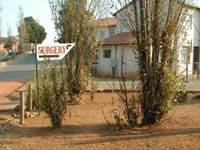
75[W]e saw a boy who had an overall on, carrying another boy in his arms and a girl next to him. She was crying, weeping, and they were coming towards us.
She asked Stanley to stop the car and ordered the little group into it to rush the child to hospital. She herself "followed them on foot to the clinic, which was not very far." But when she got there, the doctors who had tried to examine the boy "told us that he was dead already":
The little girl … was present, she was crying… [T]he boy who was carrying this other one, he said in Zulu that this boy is already dead and this girl kept on calling his name, she kept on calling him, Zolile, Zolile, as she was crying and weeping.54
Antoinette Musi called her brother by his name, but he did not answer. He was wounded and blood was "coming out through the mouth and blood [was] on the neck." At Baragwanath Hospital two doctors met them and carried Hector into the clinic. Musi stood outside:
There came a nurse who called me and directed me where to go. That is where I found the doctor inside. He asked me the name of Hector and told me that I will be a witness… I heard the doctor while I was still there, mention the word "mortuary" and I realised then that he [Hector] had passed away.55^top
Tremor
It was as if, barely buried under the dust of the streets, a network of incendiary fuses carried the terrible knowledge everywhere in Soweto: "a White man … [h]ad killed a child, a Black child."56
80Back at the offices of the West Rand Administration Board in Mphuthi Street, Dr. Edelstein, senior official in charge of welfare, returned with the windscreen of his car smashed, desperately concerned to let the staff there know that there was trouble and that they should leave the office immediately.
He came in running, and he just thumbed his right hand, and uttered something, my Lord! which I have not forgotten, he just said [to Mr Hobkirk], "I told them that it was going to happen." Then he came into our office and repeated the same words, "I told them that it was going to happen."57
The children were coming back up from Mofolo. Their number had increased tremendously and "there was a change in their mood… They were aggressive." They came up the road chanting and stoned the office and set two cars alight. The staff locked themselves into an office, and Dr. Edelstein hid under a desk, "so that the children shouldn't see him." A window broke under the onslaught of the stones:
Then the children saw me… they asked me where was the White man. I said "no he's left." … They pulled me out through the window, that they had smashed. They asked me where the White man was. They were referring to Mr Hobkirk. Mr Hobkirk, his duty is to give the youth work-seekers permits, there are times when he doesn't give to them, indicating that they are lazy, they don't want to go and work, so now the youth always have a grudge against such people. They wanted to kill the White man.58
It was clear that the children were after Hobkirk specifically, for they shouted that "Mrs. Jacques [another staff member] should not be killed as [she was] the Welfare Worker." Tlotleng was sure that the children knew nothing about Dr. Edelstein, but the children started demolishing the building:
85[P]ulling out the cabinets, there was such a great deal of noise that … he panicked and dashed out of the building. I just heard the children saying "here is the White man", then they started assaulting him and throwing him with stones—they didn't recognise him. He ran towards the tennis courts. There are some tennis courts not far away. That was the last time that I saw him, running towards the tennis courts. And at that stage the children were still assaulting him and throwing him with stones.59
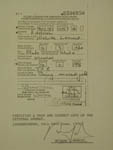 Death certificate: Melville Leonard Edelstein.
Back at the building, the children had managed to break down the locked door and started pulling out the filing cabinets and the benches
before setting everything alight. Some of the children asked Tlotleng why he was still standing there, whether he was not afraid that
they would assault him because he worked for the Bantu Administration. He left and, being worried about what might happen to the rest
of the staff, at first sought refuge with some workers who had hidden in a house nearby. Later he made his way home past the burning
Bantu Administration building at Dube, past a number of children who had looted the bottle store at Moroka and were "running around
with all the liquor that they had looted."60
Death certificate: Melville Leonard Edelstein.
Back at the building, the children had managed to break down the locked door and started pulling out the filing cabinets and the benches
before setting everything alight. Some of the children asked Tlotleng why he was still standing there, whether he was not afraid that
they would assault him because he worked for the Bantu Administration. He left and, being worried about what might happen to the rest
of the staff, at first sought refuge with some workers who had hidden in a house nearby. Later he made his way home past the burning
Bantu Administration building at Dube, past a number of children who had looted the bottle store at Moroka and were "running around
with all the liquor that they had looted."60
After the shots were fired, things got more chaotic and students began to attack many different targets:
Kutumela:At that time a Gilbey's truck passed, carrying some liquor and it was stopped by the students and they removed the liquor that was in it.
van Graan:What did they do with the liquor?
Kutumela:I would say they drank the liquor because many people were drunk that day during the day during the day.
van Graan:Who instructed them to stop the truck?
Kutumela:By that time, I would like to draw your attention that by that time we did not have a leader by that time, we were just fleeing from the police. Now anything the people came across, they just met it, as we damaged the office, as stoned the office. Now the Gilbey's truck was just stopped by students. I would not say who was who because we were just fleeing as we would now meet, not specifically students from Naledi or students from Morris.
van Graan:Who told you to stop the motor cars and force the drivers to give the Black Power salute?
Kutumela:By that time the situation was different in Soweto, because we saw some motorists and the only thing, when we … (inaudible) … just power. We just shouted it, "power, power, power," and all that. Now that thing, I stopped the vehicles and forced the people to say "power" as I was saying "power" too.
van Graan:So it was never discussed beforehand to stop the vehicles in that manner?
Kutumela:No.61
Rudolf Mandla Matimba, 25, was a teacher at Selelekela School, teaching mathematics, general science, and agriculture. He had become
involved in the student movement in 1974, although he was not invited to the student meeting on Sunday, June 13, at which the Afrikaans
issue was discussed and plans were made for the march that week. On the morning of June 16, the principal at his school had dismissed the
students at 10:30 a.m., although he had earlier denied them permission to take part in the demonstrations. Matimba stayed at the school
until 2 p.m. and then spent the afternoon with his girlfriend, a nurse at Baragwanath Hospital.
I stayed there until about 6:30 p.m. that day. On my way home I came across Tebello Motapanyane at the A1 Dry Cleaners in Orlando West. At that stage I already noticed that there were disturbances in Soweto. The traffic was moving very slowly, being stopped by tsotsis and elderly people. There were also cars nearby burning. There was a group of about 1090 people singing. I asked Tebello what happened during the day. He told me that the students had clashed with the police; that a lot of people had died during the day. He said that they were shot by the police. He said further that he was there when the bottle store was broken into. It is the Phefeni bottle store. We went nearer to the bottle store and noticed several people looting the place. He also told me how they took cool drinks and bread from various trucks. I then joined the group that was singing. I later decided to go home. On my way I saw several people pushing a Combi out of the road. It was blocking the traffic. I helped. We pushed the Combi onto the railway line site but not onto the tracks. It did not overturn. After this I went to my house which was about 600 metres from there62
Murphy Morobe also described the changing mood.
Murphy "Mafison" Morobe
Cillié Testimony, 9 February 1977
Police Statement, January 1977
TRC testimony, July 1996. The police then moved in the direction of Orlando East and parked at the open veld off the spruit. In Orlando West the stoning continued now on every delivery van or truck that the students came across. It was now a real fight against the vehicles and in one instance I was far away when I saw a green car with white persons being stoned. I did not see the end of this car and its occupants.63
Sylvia Allison Carruthers and three of her white women friends were in Soweto that morning to deliver fresh vegetables to several crèches (nursery schools or kindergartens). At one of them they found that the spirit of the uprising had touched even the children there:
[T]here were the cutest little tables and chairs, just the right sizes obviously for tinies and an interesting array of towels, blankets, overalls and so on, each marked with a symbol of some kind such as a jug or a ball or a teddy-bear so that the children could identify their particular belongings, all supplied by the crèche of course. It was all most interesting and rewarding. The babies were a happy lot and much loved and cared for children… Behind the … crèche at about half past ten, dozens of teenagers began to pour from a building which I assume was a school. Jenny and I were in the garden of the crèche looking at the various equipment and when they saw us, several of the youngsters gave us the Black Power salute, that is the clenched right fist. This was done to the accompaniment of broad grins and seemed very good-natured. The crowd of teenagers seemed most cheerful and happy.6495
At about a quarter to eleven65 the four women decided to return to Johannesburg, still unaware of any threat or that anything more than "very large numbers of schoolchildren" were about in Soweto that day. They lingered for a while over a cup of coffee, enthralled by the quaintness of it all:
And it was quite beautiful. These gorgeous little tots who were all under six years old, sang at the top of their voices in Zulu with all the appropriate actions, that is arms aloft and bosoms clutched and feet stamped as children love to do. When their teacher stopped singing, the children carried on quite spontaneously with another song on their own; it was most enjoyable.66
But in Khumalo Street, near the Orlando West High School, they found themselves surrounded by a crowd of angry youths, "a slowly moving horde of Africans," who "peered into the windows, some still with grins and Black Power salutes":
I even heard a couple of wolf whistles and at my age you notice wolf whistles. Suddenly a Bantu girl or woman, I cannot say which as she was so close to my window, all I could see of her was an enormous bosom, screamed something in an African language at the top of her voice and then thumped with both fists on the roof of the car. This was the signal for dozens of others to do the same and the noise inside the car was quite something.67
The windows of the car were smashed and all four women inside injured in one way or another. On the side of the car closest to Carruthers a "man"68 stood holding a large rock in his hand. The rock was so big that it hid his hand.
100My immediate thought was dear God, if he throws that we are dead because they will all stone us and then I watched him hurl it at us and within seconds our car was being battered by dozens of rocks, most of them very large. I was screaming at the top of my lungs after being struck by one of the rocks on the back of my head and feeling the warm blood run down my back. My back and my head were being hit by rock after rock… We were all quite sure we were going to die.69
Although their attackers rocked the car and tried to lift it, and despite a broken hand, the driver, a Mrs. Kent, continued slowly on, careful not to hurt any of the children and anger them further by moving too fast. Finally, the car broke free of the crowd, and from Orlando Bridge they were escorted to the police station and on to hospital:
I was frankly terrified and started to shout: "I am English, I am English!" to my everlasting shame. What I expected them to do because I am English I really cannot tell you. I can only say that until anyone is as frightened as I was at that moment, they cannot know what their reactions would be. I always thought I would be so brave.70 (See Carruthers testimony)
Outraged by the lack of response to her ordeal and the short shrift their story was given in the newspaper and unaware of the absurdity of her perspective, Carruthers declared that "50 years, 100 years ago, if an English woman had been attacked in an African township, they would have sent a gunboat."71 Somewhere in Soweto "the people … laughed and laughed in the bitterness of the day."72
Just before eleven o'clock a West Rand Bantu Administration Board official, J. H. B. Esterhuizen, drove along Khumalo Street straight into a group of students near the Phomolong Clinic. When he left his car he was surrounded by youths and beaten to death in an alley opposite the clinic. Although marks on his clothing and body gave the appearance that the students had tried to burn his body, it is possible that ashes clung to him from attempts that had been made to stuff it into a garbage can.73
105And then, from there, a certain man … [hesitates] … I wonder who was that man … who we throwed with stones, he was driving a car, of course, he was a white man. We throwed him with stones, because he was forcing to move within the mob, because even other motorists, when they came, when they came our direction and find out there is a mob, they would rather turn, or try to take another direction. So this man forced his way through our … through us. And then, we tried to chase him, go back, go back, go back. He insisted, and he suddenly took out the shotgun, and then when he was just about to fire one, or whether he fired one, I can't say… We started throwing stones, we started hitting him with stones, until he died, and we took a dust bin, of course, they put him inside that dust bin…74
The crumpled body lay on a sidewalk, the head in the road. But for the heavy stones all around and the odd angle at which his arm and hand were folded back up under the body the man might have been asleep.75 The body could be removed only about four hours later.76
Death was not new to Soweto and the nights were filled with the terror of a tsotsi's flick knife and the threat of a robber's flaring anger. When Derrick Thema, a black journalist, was jerked from sleep to go to where his brother lay "dead with deep panga gashes in his body," he thought of all the bodies that were discovered in the mornings and told himself "silently there was nothing spectacular about my brother's death… Death hangs around everyone's neck."77 But this was different.
By two in the afternoon police station commanders from Soweto were reporting that matters had gotten out of hand and that they did not have the
manpower to handle it. Surveying the area from a helicopter later that afternoon, Brigadier S. W. Le Roux reported large groups standing around,
blocking cars, and pelting the cars with stones and lighting them on fire.78
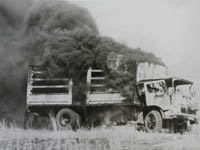
Beer halls and bottle stores (liquor stores) were among the prime targets of the uprising.
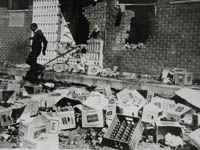
At 7 p.m. at the Meadowlands hostel compound, Lieutenant Colonel J. C. Le Roux, in charge of 74 police officers, confronted a large number of people who were coming out of a bottle store and carrying boxes of beer and bantoebier (sorghum beer). Six shops, a beer hall, and the bottle store itself were burning. "Die skare was oënskynlik besope en geweldig lawaaierig" (the crowds were apparently drunk and dreadfully noisy).83
By nightfall many of the roads in Soweto were blocked with burning vehicles, and a police car going from Moroka to Jabulani was pelted with stones near Rockville, its windscreen shattered.
The composition of the crowd had changed perceptibly:
[F]rom the time I got off from the train at Phefeni Station, there were already some people standing there, but I could not recognize any students which I know. Most of them were elderly people and mostly just tsotsis because they were wielding knives and kieries and stopping people, you know, saying that they must lift up their arms in the Black Power salute and you find that sometimes when people did that, they ripped off their watches from their hands an they stoned the cars. But I definitely did not see any students at that time.84
Tsotsis joined the crowds, following their own agendas:
115The first time I observed tsotsis when we were—when I was already up in White City, that was the first time I observed tsotsis that they were amongst us. When we were standing there, we were forcing people to make clenched fists who were from work in cars. Now it was when I observed a tsotsi, one boy was trying to take out a watch from somebody who said "power, power," and this one somebody, as he did it, he tried to pull out the watch. That is when I observed that there were tsotsis.
[…]
I think it was after two or round about two or three.85
| Layered Narratives: | Police | Press | Cillié Commission |
Tsotsis
The Director of the South African Council on Alcoholism wrote in a memorandum to the Cillié Commission in October 1976:
Die portuurgroep (peer group) oefen sterk druk uit onder jong Bantoe seuns en dogters vanweë die afwesigheid van ouerlike toesig en so word die TSOTSI-BENDE groep gevorm wat alkoholmisbruik as een van sy sterk statusnorms het. Dit wil voorkom asof hierdie tsotsi-bendes met die afbrand van drankwinkels soveel drank buitgemaak en verober het dat dit hul verantwoordelikheidsgrense (inhibisies) totaal verwyder het, sodat geweld, anargie en chaos verder hoogty gevier het. Hul waaghalsigheidsgrense is hemelhoog opgeskuif sodat grootskaalse brandstigting na verhoogde alkoholkonsumpsie geïntensiveer is en voortgewoeker het.The peer group has strong influence among young Bantu girls and boys because of the absence of parental attention, and so the TSOTSI-GANG group is formed in which alcohol misuse is a strong status norm. It seems that these tsotsi gangs carried off and seized so much alcohol with the burning of the liquor stores that their boundaries of responsibility (inhibitions) were totally taken away, so that violence, anarchy, and chaos reigned supreme. Their recklessness levels rose sky-high so that large scale arson after elevated alcohol consumption intensified and spread.86What's this?(See: SA National Council on Alcoholism, October 76)
Buildings burned everywhere. Brigadier Schalk Willem Le Roux later stated:
120(1) Dat die oproeriges almal die Swartmag teken gee en as dit nie beantwoord word nie van voertuie nie dan word daardie voertuig met klippe bestook en soms aan die brand gesteek. (2) Dat die oproeriges hulle veral toespits het op W.R.A. geboue; asook ander geboue wat deur Blankes beheer word. (3) Die woorde Black Power was veral baie uit geroep gewees. (4) Ek het ook die woorde BOER SE MOER gehoor, veral as daar 'n groep oproeriges bymekaar gestaan het en die Polisie verby gegaan het. (5) Die oproeriges het sonder enige redes klippe gegooi, paaie versper met ou wrakke, klippe en enige ander voorwerp wat hulle in die hande kon gekry het.(1) That the rioters all gave the Black Power sign and when it was not answered then that car would be pelted with stones and sometimes be set on fire. (2) That the rioters concentrated on W.R.A. buildings; as well as on other buildings controlled by whites. (3) Especially the words Black Power were shouted a lot. (4) I also heard the words BOER SE MOER, especially when there was a group of rioters standing around together and the police went by. (5) Without any provocation, the rioters threw stones, blocked roads with old [car] wrecks, stones and any other object that they could lay their hands on.87What's this?(See Le Roux testimony)
Fires in the streets lit the night sky over Soweto red, as if mocking the tragedies of the day in a sad travesty of the fiery celebrations of New Year's Eve or other township revelries. To an outsider the randomly laid-out and poorly lit streets must have been a mystery, and a daunting one at that. Out of the dark, stones were thrown at patrolling police units.88 (See: Chalmers statement) The matchbox houses were set among rocks and debris. Potholes, "as deep a children's swimming pools,"89 made the streets treacherous. Puddles of stagnant water and piles of disintegrating rubbish filled the air with evil smells and attracted the half-starved mongrels that stalked the darkness:
Soweto looked like a festival. Many young chaps were roaming the streets shouting "Black Power." Drinks were flowing like water. There [sic] had changed faces. There were no students them [sic], but young hoodlums.90
In front of the Caroline Mvuzi preschool at eleven o'clock that night, Constable Pieter Cox and Lieutenant Smit noticed a Putco bus that had clearly been hijacked. Its windows were broken and the black passengers hanging out of them raised their clenched fists and shouted "Black Power" at them. When they managed to stop the bus, everyone ran away and Lieutenant Smit ran after the driver, who was the last to get out of the bus and jumped a fence to get away. In the dark, Smit stumbled and fell over the same fence and Cox shot the fleeing figure.
^topToe luit. Smit val het ek die Bantoe geskiet. Daar was geen ander manier om die Bantoe te keer nie en as ek nie geskiet het nie sou hy weggehardloop het, in die donker tussen die huise… Ek het slegs een skoot geskiet. Ek het die Bantoe ingehaal en gevind dat hy 'n gat in sy bors het.When Lieut. Smit fell, I shot the Bantu. There was no other way to stop the Bantu and if I had not shot, he would have run away, in the dark between the houses… I only shot one time. I caught up with the Bantu and found that he had a hole in his chest.91What's this?
Evening
That evening workers began returning home. Hundreds of thousands arrived by train and bus and at once found themselves in the thick of the uprising. A black social worker,92 having spent most of the afternoon pleading with students not to harm the white social-work student who had been with her in Soweto that day working on juvenile cases, finally saw her safely to the Orlando police station. As she left the station to go home she met people returning from Johannesburg:
125They looked amazed as they saw a convoy of police cars and hippos and police in camouflage uniforms. To me they appeared amazed and ignorant of what was happening and at the same time frightened of the "soldiers" … that is the police in camouflage uniforms. On the other hand children who were no longer in school uniform, though some were still in it, appeared to be enjoying the sight of a helicopter threatening to land just above their heads.93
The fury and the pain of the parents who returned home that evening was great. "Those people whose children had been shot in Soweto—they now want to die," a motor mechanic remembered. "Imagine how they felt coming home from work. Their children were killed for no reason."94 A new and powerful force had now joined the embattled schoolchildren. "Earlier in the evening adults returning from work took over the barricades and general lawlessness took hold for a time."95
Ntsiye April Mahasha's son, Daniel, was shot by the railway police at Merafe station on Thursday, June 17, possibly while he was playing soccer with his friend Pitso. The evening before, his father had seen Daniel among other schoolchildren and "jong mense" (young people) who had been running up and down the streets, thrusting their right-hand fist into the air and screaming "Power, Power." The father remained uninvolved:
Ek het niks verder gehoor nie en my seun het ook nie gesê waarom hulle so maak nie en ek het nie verder gevraa nie en gaan slaap.I didn't hear anything further and my son also did not say why they were doing this, nor did I ask further and went to bed.96What's this?
Ntsiye April Mahasha Police Statements:
21 June 1976
28 June 1976
There is pathos in the father's description of his son, who "was 15 jaar oud, skolier by Moletsani Bantoeskool en het by my ingewoon …
was gesond en sterk en sover ek weet het hy nooit gedrink nie" (was 15 years old, a student of Moletsani Bantuschool and lived with me…
He was healthy and strong and as far as I know he never drank).97
It seemed it had been a long time since parents had listened to their children.
I used to say to my mother and father: "Do you know what discrimination means? Do you know what it does to people? It kills them very slowly." They would tell me to hush, and look at me as though I was saying something that was very bad, very evil. "You are getting a good education," they would say. "Why do you want to destroy what we have done for you?" I could not give them an answer.98
Until the children took action, many parents despaired.
We stood on the sidelines, arms folded. Sometimes we were swept by the waves of moments of crisis. Now the children cried "Enough!" So, we have begun to see alternatives; we've begun to echo the cries uttered in the middle of the street, at street corners, in church buildings, at night-vigils and in the toilets of school buildings. Something definitive, something positive rings in the shrill voices we raise when we speak.99
Even the parents, who, according to Captain Hendrik Jurgens Greyffenberg,, pulled their children out of demonstrating groups and beat them, may have acted out of fear for their lives at the hands of the police more than condemnation.
135Baie van die kinders se ouers het opgedaag en hulle kinders uit die groep gehaal en slae gegee. Ongeveer 15h00 dieselfde dag het ons ook by die Gordon Laërskool te 6de laan waar kinders besig was om versperrings oor die strate te pak ouers aangetref wat self hulle kinders gevang en geslaan het.Many of the children's parents showed up and took their children out of the group and gave them hidings. At about 3 p.m. that same day at the Gordon primary school in 6th Avenue where children were busy setting up roadblocks across the streets, we encountered parents who themselves caught their children and hit them.100What's this?(See: Greyffenberg statement)
Parents were worried and afraid:
They didn't want me to go with the crowds, because they said they didn't want me to die. They tried to stop me, but each time I slipped out. I would climb the fence at the back of our house.101
To the police, the schoolchildren's challenge of parental authority came as a shock. They were eager for any sign that parents had once again taken control of the younger generation. By August 28, 1976, Colonel T. J. Swanepoel, a colonel of the South African Police in Hillbrow, had reported:
Die werkerselement en ander wetsgehoorsame inwoners van Alexandra het nou sterk na vore getree en die oproermakers word op die oog af deeglik aan bande gelê deur die inwoners self. 'n Ander opvallende kenmerk is dat die leeglêer en tsotsi elemente en waarskynlik ook die leierskorps van die oproermakers se getalle opmerklik in Alexandra verminder het. Dit wil voorkom of die ouers nou weer volle beheer oor hulle kinders het en nie toelaat dat hulle kinders vir hulle voorskryf wat om te doen nie. 'n Voorbeeld wat hierdie mening onderskryf, is gevind op 23 en 24/8/1976 waar daar ooglopend pogings aangewend was om werkers so te intimideer dat hulle op genoemde twee datums nie moes gaan werk nie. Dit was op die oggende van 23 en 24/8/1976 gevind dat die werkers van Alexandra op volle sterkte gaan werk het. Putco busse het ongehinderd en normaal geloop in Alexandra. 'n Ander opvallende kenmerk was dat kinders en die leeglêer element glad nie toegelaat was om op straat te verskyn voor ongeveer 07h30, toe van die kinders opgemerk is wat op pad skool toe was. [Emphasis added.]The worker component and other law-abiding residents of Alexandra now stepped forward strongly and on the face of it the rioters were thoroughly kept in check by the residents themselves. Another remarkable characteristic was that the numbers of delinquents and the tsotsi element and probably also the leadership group of the rioters noticeably declined in Alexandra. It seems as if the parents now again had full control over their children and did not allow them to prescribe to them what to do. An example that underwrites this opinion was found on the 23rd and 24th August 1976 when obvious attempts were made to intimidate workers so that they would not go to work on those two date. It was found on the morning of the 23rd and 24th August 1976 that the workers of Alexandra were going to work in full force. Putco busses were running unhindered and normally in Alexandra. Another noticeable characteristic was that children and the delinquent element were not permitted to appear on the road at all before about 7:30 am, at which time some children were noticed who were on the way to school. [Emphasis added.]102What's this?(See: Swanepoel testimony)
Notes:
Note 42: Egbert du Toit Botha (South African Police), statement, SAB K 345, vol. 86. back
Note 43: Marthinus Johannes Hattingh (sergeant, South African Police, Soweto), statement, SAB K345, vol. 85, file 2/2/1/12/12, part 4. back
Note 44: Sophie Tema, testimony, 21 September 1976, SAB K345, vol. 139, file 2/3, part 1, Commission Testimony vols. 9 and 10. back
Note 45: Murphy "Mafison" Morobe, testimony, 9 February 1977, SAB K345, vol. 148, file 2/3, part 19, Commission Testimony vol. 102, p. 4925. back
Note 46: Murphy Morobe , interview, Radio 702, 16 June 1993. back
Note 47: The Rand Daily Mail (Johannesburg) published Victor Dladla's eyewitness account under the headline "Shots before the Stones," 17 June 1976. back
Note 48: Christiaan Johannes Marais Loubser (captain, South African Police, Orlando), statement, SAB K345, vol. 86, file 2/2/1/12/12, part 5. back
Note 49: Elliot Ndlovu, testimony, 23 July 1996, Truth and Reconciliation Commission, Human Rights Violations, Submissions (Questions and Answers), Case: Soweto, Johannesburg, day 2. Transcript available at http://www.doj.gov.za/trc/trc_frameset.htm (Human Rights Violations, Hearings and Submissions; Hearing Transcripts; Johannesburg; Victim Hearings; Elliot Ndlovu [Soweto, 22-26 July 2006]). back
Note 50: Marthinus Johannes Hattingh (sergeant, South African Police, Soweto), statement, SAB K345 vol. 85, file 2/2/1/12/12, part 4. back
Note 51: Antoinette Musi, testimony, 21 September 1976, SAB K345, vol. 139, file 2/3, part 1. back
Note 52: Mashabela, Black South Africa. back
Note 53: Photograph by Sam Nzima reprinted in Gorodnov, Soweto. back
Note 54: Sophie Tema, testimony, 21 September 1976, SAB K345, vol. 139, file 2/3, part 1, Commission Testimony vols. 9 and 10. back
Note 55: Antoinette Musi, testimony, 21 September 1976, SAB K345, vol. 139, file 2/3, part 1. Commission Testimony vol. 9. back
Note 56: Samuel S. Tlotleng, testimony, SAB, civil-court case WLD 6857/77, West Rand Bantu Administration v. Santam (WRAB v. Santam), p. 3915. back
Note 57: Ibid. back
Note 58: Ibid., 3910-16. back
Note 59: Ibid. back
Note 60: Ibid. back
Note 61: David Lisiwe Kutumela, testimony, 9 February 1977, SAB K345, vol. 148, file 2/3, part 19, Commission Testimony vol. 103, p. 4973. back
Note 62: Rudolf Mandla Matimba, testimony, 8 February 1977, SAB K345, vol. 148, pp. 4865-66. back
Note 63: Murphy Morobe , testimony, 9 February 1977, SAB K345, vol. 148, file 2/3, part 19, commission vol. 102, pp. 4901-2. back
Note 64: Sylvia Allison Carruthers, testimony, 13 September 1976, SAB K345, vol. 139, file 2/3, part 1. back
Note 65: Ibid. In her original testimony, Sylvia Allison Carruthers stated that the time was 11:45 a.m. There is a discrepancy between this and the time given in the Cillié Commission's chronology of events. back
Note 66: Ibid. Clearly, Yutar, the advocate who questioned Carruthers, was similarly taken by the pretty picture:
backYutar:Incidentally, I think this was one of the sites the Commission saw last Tuesday. Tiny little tots all dressed in uniforms.
Carruthers:Yes.
Yutar:Romping …
(intervenes—both speaking simultaneously)
Yes, and playing there happily.
Carruthers:Yes, very well-equipped crèches indeed.
Yutar:And wanting the opportunity to sing for visitors who might come and enjoy doing so.
Carruthers:Thoroughly doing so, yes.
Yutar:We saw that last Tuesday.
Note 67: Sylvia Allison Carruthers, testimony, 13 September 1976, SAB K345, vol. 139, file 2/3, part 1. back
Note 68: Ibid. The importance of determining whether the stone thrower was a man, youth, or child becomes clear in the following exchange between Advocate Yutar and Mrs. Carruthers:
backCarruthers:I caught sight of a man and I repeat man, not teenage boy.
Yutar:If I can just stop there for a moment. When we did an inspection, we noticed some of the school children, some were young, others were not so young. Now, somebody might have been as old as 18 or 20 still at school. Now when you refer to this man are you perhaps not making—are you not in error? Was it a—do you think it was a student or was it a full grown man?
Carruthers:This man was—he was not a middle-aged man by any means; I would have put him at about 26 or so, but he certainly was not a 15 or 16 year old.
Yutar:Or not a 20 year old?
Carruthers:I could not honestly say that because well, how does one tell the ages? He was a big man, he was powerfully built, he looked about 26 to me.
Note 69: Ibid. back
Note 70: Ibid. back
Note 71: Ibid. back
Note 72: Sepamla, A Ride on the Whirlwind, 57. back
Note 73: See also Cillié Report, 1:124. back
Note 74: Lilli Mokganyetsi, interview by Helena Pohlandt-McCormick, tape recording, Johannesburg, December 1993. See also Part 6 of this book. back
Note 75: Photograph by Magubane, June 16, 1976. back
Note 76: See Cillié Report, 1:124. back
Note 77: Derrick Thema, quoted in Peter Magubane (photographer), Marshall Lee (text), and Dawn Lindberg (ed.), Soweto (Cape Town: D. Nelson, 1978), 76-77. back
Note 78: Schalk Willem Le Roux (brigadier, South African Police, Soweto), statement, SAB K345, vol. 86: "Verskei[e] Stasiebevelvoerders het my toe verwittig dat die aangeleentheid hand uit geruk het en dat hulle nie die mannekrag het nie om dit te handteer nie." (Different station commanders then assured me that events had gotten out of hand and that they did not have the manpower to handle it.) back
Note 79: Lilli Mokganyetsi, interview conducted by the author, tape recording, Johannesburg, December 1993. back
Note 80: Photograph by Magubane, June 16. back
Note 81: See Cillié Report, 1:526. back
Note 82: Frans, "The first night of the riot in Soweto, (Wed. 16.6.76)," personal account in SAB K345, vol. 133, part 14. back
Note 83: Jacobus Conradie Le Roux (lieutenant colonel, South African police, Krugersdorp), statement, SAB K345, vol. 86, part 5. back
Note 84: Rudolf Mandla Matimba, testimony, 8 February 1977, SAB K345, vol. 148, 4866-67. back
Note 85: David Lisiwe Kutumela, testimony, 9 February 1977, SAB K345, vol. 148, file 2/3, part 19, Commission vol. 103, pp. 4973-74. back
Note 86: E. F. Louw (director, South African Council on Alcoholism), Memorandum, 3 October 1976, SAB K345, vol. 127, file 2/2/7, part 1. back
Note 87: Schalk Willem Le Roux (brigadier, South African police, Soweto), statement, SAB K345, vol. 86, part 5. back
Note 88: Jan Andries Chalmers (lieutenant, South African Police, Roodepoort), statement, SAB K345, vol. 84, file 2/2/1/12/12, part 3: "Die res van die nag het ons gepatrolleer. Daar was telkens uit die donker klippe na ons gegooi" (We patrolled the remainder of the night. Occasionally stones were thrown at us out of the dark). back
Note 89: This description is based on Mbulelo Vizikhungo Mzamane, The Children of Soweto (Essex: Longman, 1982), 67-68. back
Note 90: Thomas, "Soweto Riots—16.6.76; Personal Experiences," personal account, SAB K345, vol. 133, part 14. back
Note 91: C. P. Cox (constable, South African Police), statement, SAB K345, vol. 84, file 2/2/1/12/12, part 3: Memoranda and Evidence. back
Note 92: SAB K345, vol. 140, testimony. This person asked the Commission that her name and anything that would identify her not be published. I will also honor the request. back
Note 93: Ibid. back
Note 94: Motor mechanic quoted in Financial Mail (Johannesburg), 17 June 1976. back
Note 95: Rand Daily Mail (Johannesburg), 17 June 1976. back
Note 96: Ntsiye April Mahasha (civilian), statement, SAB K345, vol. 86. back
Note 97: Ibid. back
Note 98: Anonymous students, girls age 15, in Gorodnov, Soweto, 294-95. back
Note 99: Sepamla, A Ride on the Whirlwind, 26. back
Note 100: Hendrik Jurgens Greyffenberg (captain, South African Police, Randburg), statement, SAB K345, vol. 85, file 2/2/1/12/12, part 4. Here Greyffenberg describes events in Alexandra township in early July 1976. back
Note 101: Anonymous student, girl age 15, "Sowetans Speak for Themselves," in Gorodnov, Soweto, 295. back
Note 102: Theunis Jacobus Swanepoel (colonel, South African Police, Hillbrow), testimony, SAB K345, vol. 140, file 2/3, part 3, Commission Testimony vol. 16. back
